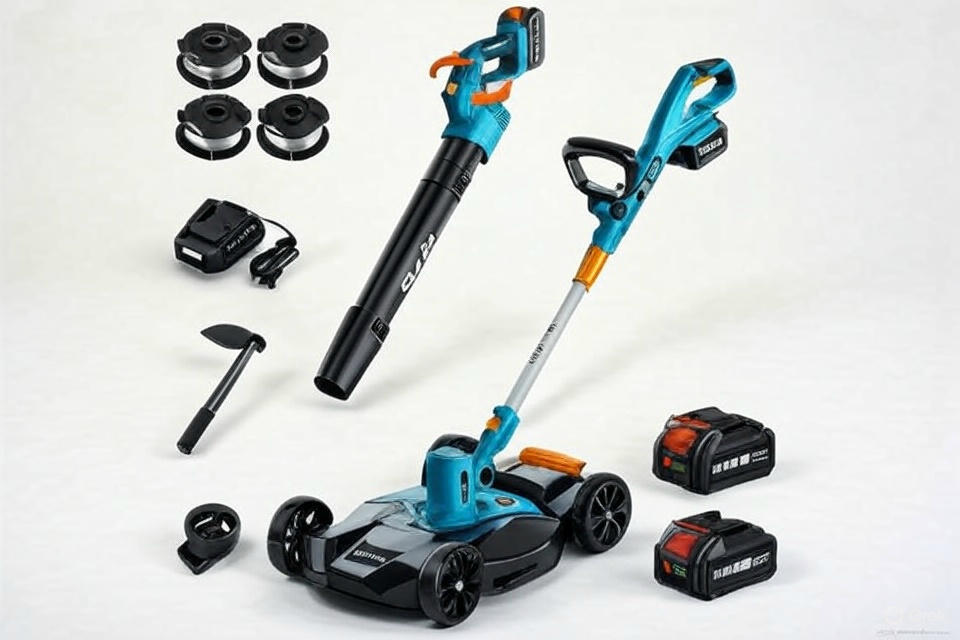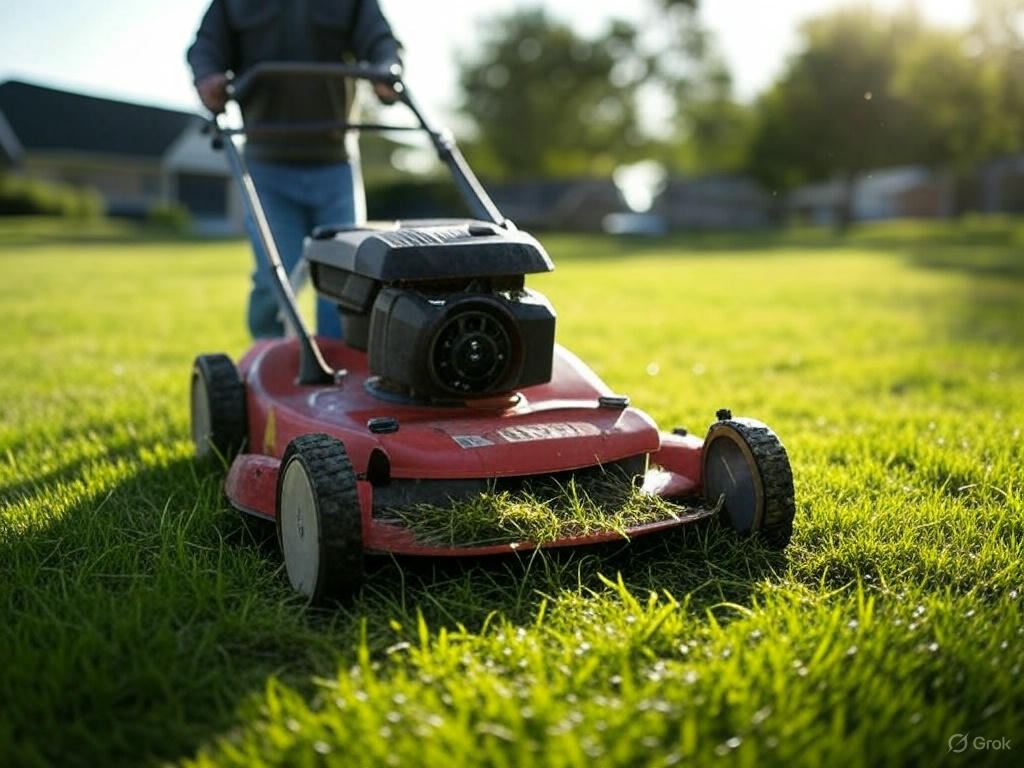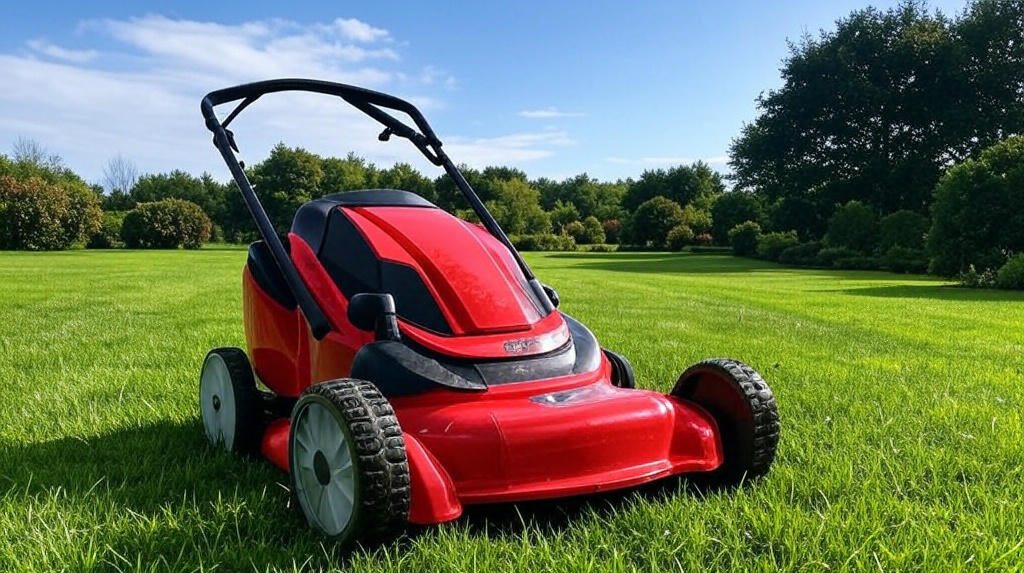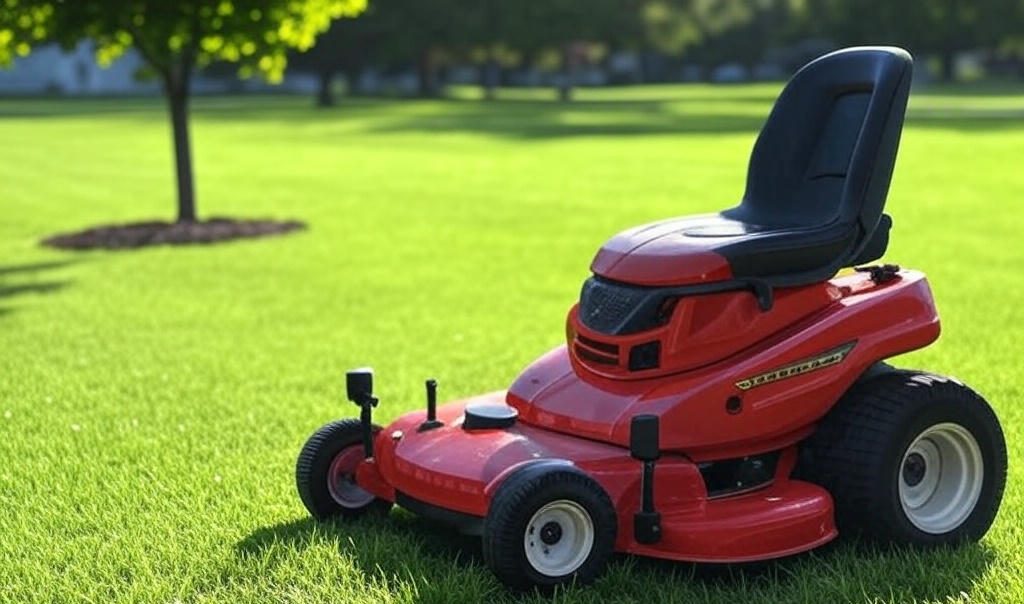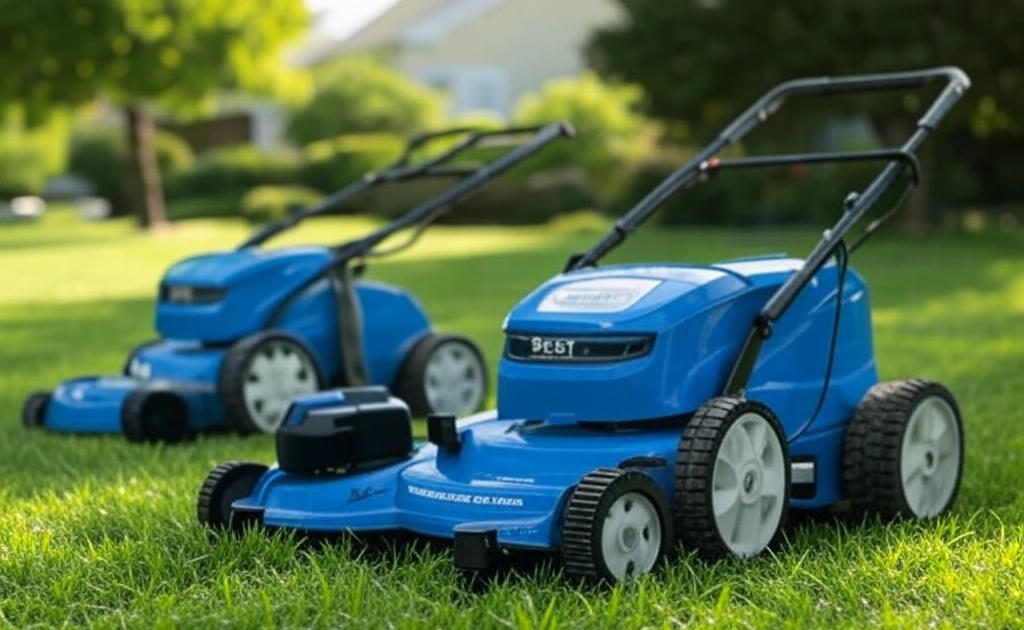Finding the perfect small lawn mower for your compact yard can transform your weekly grass cutting routine from a dreaded chore into a quick, manageable task. Small lawn mowers offer homeowners with limited storage space and modest-sized yards an efficient solution that doesn’t sacrifice cutting performance for convenience.
The market overflows with options ranging from traditional push reel mowers to modern cordless electric models. Each type brings unique advantages that cater to different yard sizes, grass types, and personal preferences. This comprehensive guide examines five top-performing small lawn mowers that have earned recognition for their reliability, cutting precision, and user-friendly features.
Contents
Why Choose a Small Lawn Mower?
Small lawns require specialized equipment that matches their scale. Traditional full-sized mowers often prove cumbersome and inefficient for yards under 5,000 square feet. Compact mowers navigate tight spaces with ease while consuming less storage space in garages, sheds, or utility closets.
Energy efficiency ranks among the primary benefits of small lawn mowers. Battery-powered models eliminate fuel costs and reduce environmental impact compared to gas-powered alternatives. Electric motors operate quietly, allowing early morning or late evening mowing without disturbing neighbors.
Maintenance requirements decrease significantly with smaller mowers. Fewer moving parts mean reduced repair costs and simpler upkeep routines. Many models feature tool-free adjustments and easy-clean designs that save time during seasonal maintenance.
Weight considerations favor small mowers for users who struggle with heavy equipment. Lightweight designs reduce physical strain while maintaining cutting effectiveness across various grass types and terrain conditions.
Types of Small Lawn Mowers
Cordless Electric Mowers
Battery-powered mowers dominate the small lawn care market due to their convenience and environmental benefits. Lithium-ion batteries provide consistent power delivery throughout cutting sessions while eliminating cord management issues.
Runtime varies between models, with most offering 30-60 minutes of continuous operation per charge. Battery capacity directly impacts cutting duration, making it essential to match battery specifications with yard size requirements.
Charging times typically range from 60-120 minutes, allowing multiple cutting sessions per day when needed. Fast-charging technology reduces downtime between uses, especially important during peak growing seasons.
Push Reel Mowers
Manual reel mowers represent the most traditional and eco-friendly option for small yard maintenance. These human-powered machines operate silently while providing excellent exercise opportunities for health-conscious homeowners.
Cutting quality often surpasses electric alternatives due to the scissor-like cutting action that cleanly shears grass blades rather than tearing them. This precise cutting promotes healthier grass growth and reduces browning at blade tips.
Maintenance requirements remain minimal since reel mowers contain no motors, batteries, or complex electrical components. Occasional blade sharpening and basic cleaning constitute the primary upkeep tasks.
Combination Tools
Multi-function lawn care tools combine mowing capabilities with trimming and edging features in single units. These versatile machines appeal to homeowners seeking comprehensive yard care solutions without investing in multiple separate tools.
Space-saving designs make combination tools ideal for apartments, condos, and homes with limited storage capacity. Single-tool operation reduces learning curves and simplifies equipment management.
Cost efficiency improves when purchasing one multi-function unit versus multiple specialized tools. Initial investment costs often prove lower than buying separate mowers, trimmers, and edgers.
Top 5 Best Small Lawn Mowers – Detailed Reviews
1. BLACK+DECKER Combination String Trimmer, Lawn Mower, and Edger, Cordless 3-in-1 (MTC220)
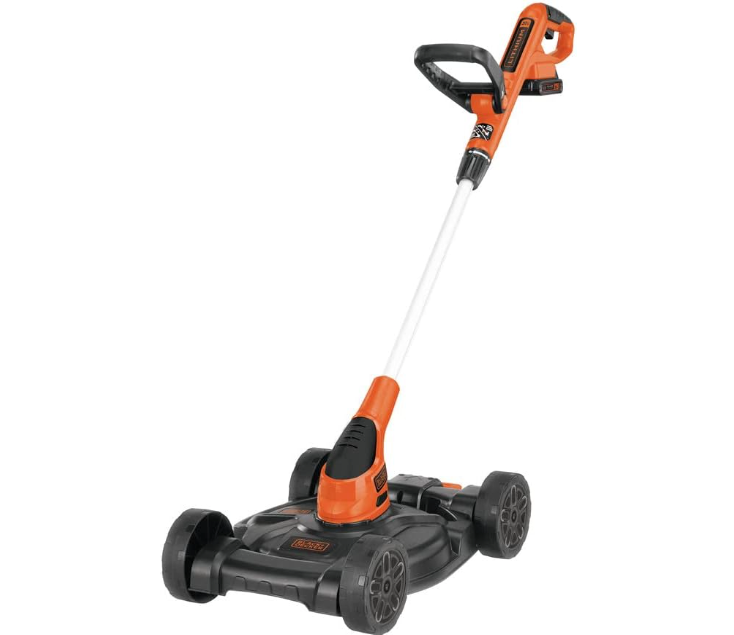
The BLACK+DECKER MTC220 stands as a versatile solution for homeowners seeking comprehensive lawn care capabilities in a single, compact package. This innovative 3-in-1 tool transforms from string trimmer to lawn mower to edger with simple adjustments, making it perfect for small yards with varied maintenance needs.
Key Features:
- 3-in-1 functionality eliminates need for multiple tools
- Cordless design provides unrestricted movement
- Lightweight construction reduces user fatigue
- Easy conversion between different modes
- Compact storage footprint
Performance Analysis: The MTC220 excels in versatility rather than raw cutting power. As a string trimmer, it handles overgrown grass and weeds effectively around fence lines, garden beds, and hard-to-reach areas. The mowing function works best on smaller lawns with relatively short grass, though it may struggle with thick or tall growth.
Battery life provides approximately 30-45 minutes of continuous operation, sufficient for most small yard applications. The automatic feed spool system maintains consistent string length during trimming operations, reducing interruptions for manual adjustments.
Conversion between modes requires minimal effort and no additional tools. The pivoting head adjusts smoothly from vertical trimming position to horizontal mowing orientation. Edging mode creates clean lines along sidewalks and driveways with precision comparable to dedicated edging tools.
Pros:
- Space-saving 3-in-1 design
- No gas, oil, or cord requirements
- Quiet operation suitable for residential areas
- Minimal maintenance needs
- Affordable entry point for cordless lawn care
Cons:
- Limited cutting width reduces efficiency on larger areas
- Battery life may require recharging during extended sessions
- String replacement can be messy
- Less powerful than dedicated single-function tools
Best For: Homeowners with small yards (under 2,000 sq ft) who need versatile trimming, mowing, and edging capabilities in one tool.
2. RB 9″ Cordless Lawn Mower, 40V 2Ah Battery & Charger
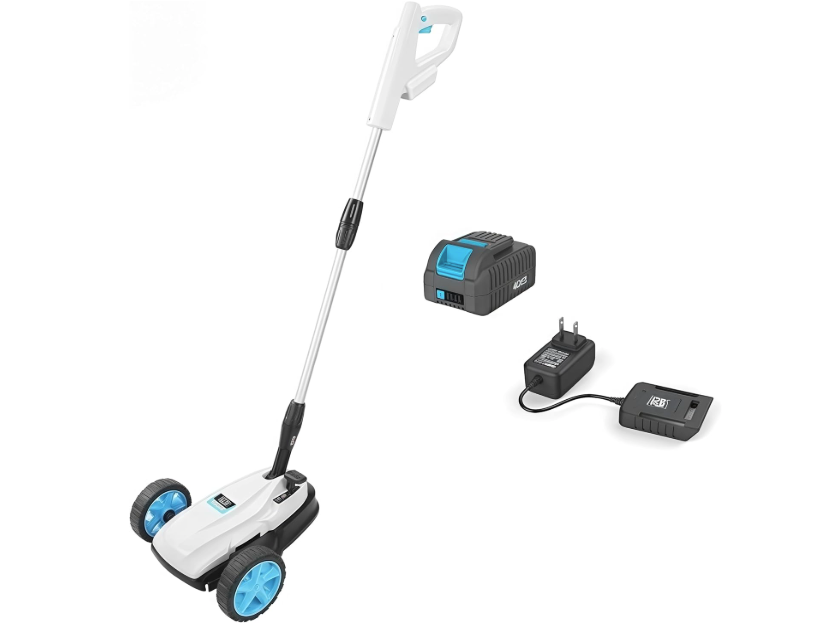
The RB 9-inch cordless lawn mower brings professional-grade features to compact yard maintenance. This innovative mower combines a powerful brushless motor with smart design elements that maximize cutting efficiency while minimizing storage requirements.
Key Features:
- 40V lithium-ion battery system
- Brushless motor technology for extended life
- 6000 RPM cutting speed
- Three adjustable cutting heights (1.2″ to 2″)
- One-hand steering system
- Upright storage capability
- Detachable handle design
- Safe tilt operation from 20° to 70°
Performance Analysis: The brushless motor delivers consistent power throughout the battery charge cycle, maintaining cutting performance even as battery levels decrease. The 6000 RPM blade speed handles various grass types effectively, from fine fescue to thicker bermuda varieties.
Three cutting height adjustments accommodate different grass preferences and seasonal requirements. The range from 1.2 to 2 inches suits most residential lawn care needs while preventing scalping on uneven terrain.
One-hand steering provides exceptional maneuverability around obstacles, garden beds, and tight corners. The lightweight design reduces operator fatigue during extended cutting sessions while maintaining stability on slopes up to 20 degrees.
Upright storage capability maximizes space efficiency in garages, sheds, and closets. The compact footprint when stored vertically takes up minimal floor space compared to traditional horizontal storage methods.
Pros:
- Powerful brushless motor technology
- Excellent maneuverability with one-hand steering
- Space-efficient upright storage
- Safe operation on moderate slopes
- Quick charging battery system
- Detachable components for easy maintenance
Cons:
- 9-inch cutting width requires more passes on larger areas
- Premium pricing compared to basic models
- Limited runtime with 2Ah battery
- Replacement parts may be expensive
Best For: Tech-savvy homeowners with small to medium yards who appreciate advanced features and don’t mind paying premium prices for quality engineering.
3. SEESII Electric 12″ Lawn Mower and Leaf Blower Combo Kit
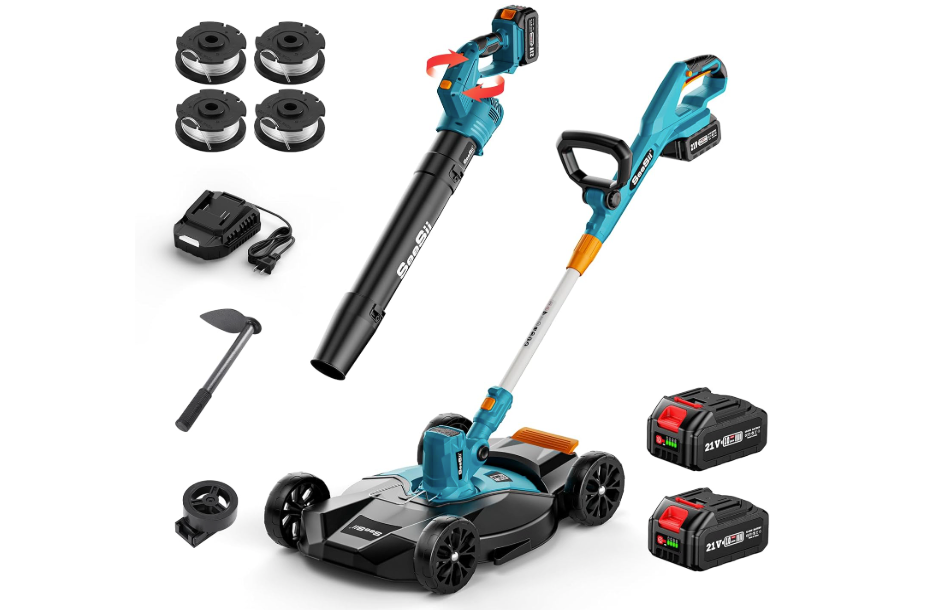
The SEESII combo kit represents exceptional value for homeowners seeking multiple lawn care functions without breaking the budget. This comprehensive system includes a 12-inch lawn mower, string trimmer, and leaf blower, providing complete yard maintenance capabilities in one purchase.
Key Features:
- 3-in-1 functionality (mower, trimmer, blower)
- 12-inch cutting width
- Adjustable cutting heights (1.3″ and 2.1″)
- 5-speed leaf blower
- Cordless battery operation
- Rotary handheld blower design
- Complete kit with battery and charger
Performance Analysis: The 12-inch cutting width provides good coverage for small lawns while remaining maneuverable in tight spaces. The wider cutting path reduces the number of passes required compared to smaller alternatives, improving efficiency on yards up to 3,000 square feet.
Two cutting height options accommodate most grass types and seasonal preferences. While limited compared to models with continuous adjustment, the available heights suit typical residential lawn care needs.
The integrated leaf blower function extends utility beyond grass cutting. Five speed settings provide versatility for different cleanup tasks, from light debris removal to moving heavier leaf accumulations.
String trimmer functionality handles detail work around landscape features, fence lines, and garden borders. The transition between different modes requires minimal setup time, making it practical for comprehensive yard maintenance sessions.
Pros:
- Excellent value with three tools in one kit
- 12-inch cutting width improves efficiency
- Variable-speed blower for different tasks
- Complete package includes battery and charger
- Suitable for comprehensive yard maintenance
Cons:
- Only two cutting height options
- Build quality may not match premium brands
- Battery life varies significantly between functions
- Limited warranty coverage
- Replacement parts availability uncertain
Best For: Budget-conscious homeowners who need multiple lawn care tools and prioritize value over premium features.
4. American Lawn Mower Company 1204-14 14-Inch 4-Blade Push Reel Lawn Mower

The American Lawn Mower Company 1204-14 represents traditional lawn care at its finest. This manual push reel mower delivers superior cutting quality while operating completely silent and requiring zero electricity or fuel.
Key Features:
- 14-inch cutting width
- 4-blade reel design
- Manual push operation
- Adjustable cutting height (0.5″ to 1.75″)
- All-steel construction
- 8.5-inch wheels for smooth rolling
- Tool-free height adjustment
- 10-inch cutting reel diameter
Performance Analysis: The 4-blade reel system creates a precise scissor-cutting action that cleanly shears grass blades rather than tearing them. This cutting method promotes healthier grass growth and eliminates the brown tips often associated with rotary mowers.
Manual operation requires moderate physical effort but provides excellent exercise opportunities. The smooth-rolling 8.5-inch wheels reduce pushing resistance on level terrain, though slopes and thick grass demand more energy input.
Cutting height adjustment ranges from 0.5 to 1.75 inches, suitable for most residential grass types. The tool-free adjustment system allows quick changes without requiring additional equipment.
The 14-inch cutting width strikes an optimal balance between efficiency and maneuverability. This width covers ground effectively while remaining narrow enough for gates, pathways, and tight spaces.
Pros:
- Superior cutting quality promotes grass health
- Completely silent operation
- No fuel, electricity, or battery costs
- Minimal maintenance requirements
- Environmentally friendly operation
- Excellent build quality with steel construction
Cons:
- Requires physical effort to operate
- Limited effectiveness on tall or thick grass
- Struggles with wet grass conditions
- Height adjustment range may be limiting
- Not suitable for slopes or uneven terrain
Best For: Environmentally conscious homeowners with small, well-maintained lawns who appreciate quiet operation and don’t mind manual exercise.
5. LawnMaster LMRM1602 Push Reel Lawn Mower 16-Inch 5-Blade
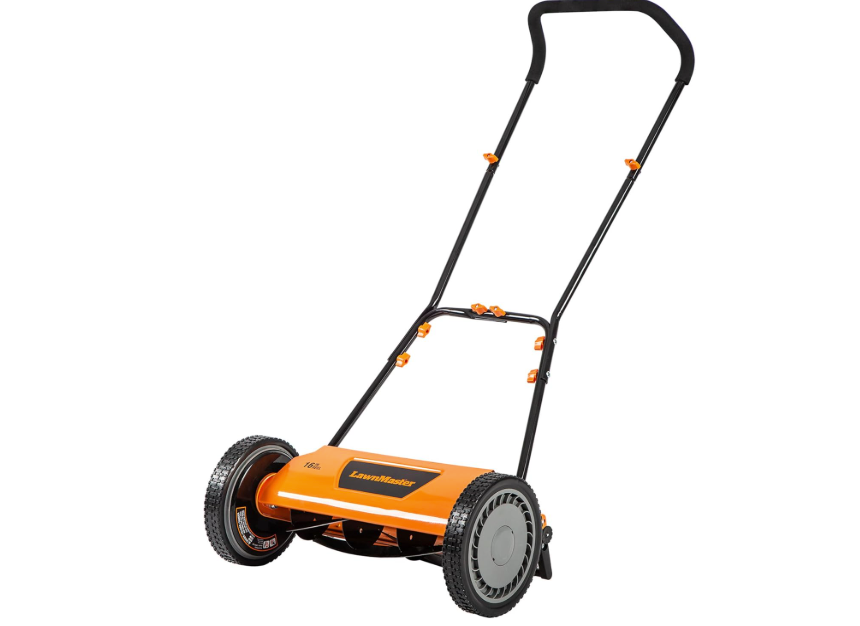
The LawnMaster LMRM1602 elevates manual lawn care with enhanced cutting performance and user-friendly features. This 16-inch reel mower incorporates modern design elements while maintaining the environmental benefits of manual operation.
Key Features:
- 16-inch cutting width
- 5-blade cutting reel
- Manual push operation
- Height adjustment from 1″ to 3″
- 10-inch rear wheels
- Grass discharge chute
- Powder-coated steel frame
- Ball bearing wheels
Performance Analysis: The 5-blade reel configuration provides more cuts per revolution than 4-blade alternatives, resulting in finer grass clippings and improved cutting consistency. This enhanced cutting action works effectively on various grass types while maintaining the health benefits of scissor-cutting.
The 16-inch cutting width represents the largest option in this comparison, reducing the number of passes required for yard coverage. This increased efficiency makes manual operation more practical for larger small yards.
Height adjustment from 1 to 3 inches accommodates a broader range of grass preferences compared to shorter-range alternatives. This flexibility suits different grass varieties and seasonal maintenance approaches.
Large 10-inch rear wheels improve rolling efficiency and maneuverability. The ball-bearing wheel construction reduces rolling resistance while enhancing durability for extended use.
Pros:
- Widest cutting path improves efficiency
- 5-blade design enhances cutting quality
- Extended height adjustment range
- Large wheels reduce pushing effort
- Durable steel construction
- Grass discharge chute prevents clogging
Cons:
- Heavier than smaller reel mowers
- Requires more storage space
- Higher initial cost than basic models
- Still limited to manual power
- Performance depends on grass conditions
Best For: Homeowners with larger small yards who want the benefits of reel cutting with improved efficiency and don’t mind manual operation.
Comprehensive Buying Guide
Determining Your Yard Size and Needs
Accurate yard measurement forms the foundation of smart mower selection. Small lawns typically range from 500 to 5,000 square feet, but terrain complexity matters as much as total area. Measure length and width of grassy areas, accounting for obstacles, slopes, and irregular shapes.
Grass type influences mower choice significantly. Cool-season grasses like fescue and bluegrass respond well to both rotary and reel cutting. Warm-season varieties such as bermuda and zoysia may require more powerful motors or sharper reel blades for optimal results.
Maintenance frequency expectations affect power requirements. Weekly cutting demands less power than bi-weekly schedules, which may encounter taller, thicker grass growth.
Power Source Considerations
Battery Technology: Lithium-ion batteries dominate modern cordless mowers due to superior energy density and longer life cycles. Voltage ratings typically range from 20V to 40V, with higher voltages generally providing more power and longer runtime.
Battery capacity, measured in amp-hours (Ah), directly impacts operating duration. Small yard applications usually require 1.5-4.0 Ah capacity, providing 20-60 minutes of continuous operation.
Charging infrastructure considerations include available outlets near storage areas and charging time requirements. Fast-charging systems reduce downtime but may cost more initially.
Manual Operation: Reel mowers eliminate power source concerns entirely while providing silent operation and zero operating costs. Physical fitness requirements and terrain limitations must be carefully evaluated.
Corded Electric: While less common in small mower applications, corded models offer unlimited runtime for yards with convenient outlet access. Cord management and safety considerations limit their appeal for most users.
Cutting Performance Factors
Cutting Width: Narrow cutting widths (8-12 inches) excel in tight spaces and detailed work but require more passes for coverage. Wider options (14-16 inches) improve efficiency while maintaining maneuverability advantages over full-sized mowers.
Height Adjustment: Multiple cutting height options accommodate different grass types and seasonal preferences. Look for easy-adjustment mechanisms that don’t require tools for quick changes.
Blade Types: Rotary blades work well for most grass types and handle varied conditions effectively. Reel blades provide superior cutting quality but require consistent grass height and dry conditions for optimal performance.
Storage and Portability Features
Compact Design: Folding handles, detachable components, and upright storage capabilities maximize space efficiency in crowded storage areas. Measure available storage space before purchasing to ensure proper fit.
Weight Considerations: Lighter mowers reduce operator fatigue and simplify transport between storage and use locations. Balance weight concerns with durability requirements for long-term satisfaction.
Weather Protection: Consider storage location protection from moisture, temperature extremes, and UV exposure. Some materials require covered storage for optimal longevity.
Budget and Value Analysis
Initial Investment: Entry-level models start around $100-200 for basic manual or electric options. Premium features and advanced technology can push costs to $400-600 for top-tier models.
Operating Costs: Electric models incur electricity costs for battery charging, typically $10-30 annually for small yard applications. Manual mowers have zero operating costs beyond occasional maintenance.
Maintenance Expenses: Budget for blade sharpening, battery replacement (every 3-5 years), and general maintenance supplies. Quality models typically require less frequent service than budget alternatives.
Long-term Value: Consider total cost of ownership over expected lifespan. Higher-quality initial investments often provide better long-term value through reduced maintenance needs and longer operational life.
Maintenance and Care Tips
Battery Care for Electric Models
Proper battery maintenance extends life and maintains performance throughout ownership. Store batteries in moderate temperatures between 32-77°F to prevent capacity degradation from extreme heat or cold.
Avoid complete discharge cycles when possible. Lithium-ion batteries perform best when maintained between 20-80% charge levels for regular storage. Complete discharge should occur only monthly to calibrate charge indicators.
Clean battery contacts regularly with dry cloth or light abrasive to remove corrosion and ensure good connections. Poor contact increases resistance and reduces power delivery efficiency.
Replace batteries showing significant capacity loss or failure to hold charge. Most lithium-ion batteries require replacement every 3-5 years depending on usage patterns and care quality.
Blade Maintenance
Sharp blades ensure clean cuts and reduce power consumption in electric models. Inspect blade condition monthly during growing season, looking for chips, nicks, or excessive wear.
Professional sharpening services typically cost $15-30 and should be performed annually or when cutting quality deteriorates. Some users prefer purchasing replacement blades rather than sharpening services.
Balance checks prevent vibration and premature wear of mower components. Properly balanced blades improve cutting performance while reducing stress on motors and drive systems.
Safety procedures must be followed during blade maintenance. Disconnect batteries, use proper tools, and consider professional service for complex repairs.
Cleaning and Storage
Regular cleaning prevents grass buildup and corrosion damage. Remove clippings from cutting deck, wheels, and other components after each use when possible.
Pressure washing can damage electrical components and should be avoided. Use garden hose with moderate pressure and avoid direct spray on battery compartments or motor housings.
Seasonal storage preparation includes thorough cleaning, battery removal or full charging, and dry storage location selection. Cover mowers to prevent dust accumulation and UV damage to plastic components.
Lubrication points require periodic attention according to manufacturer specifications. Over-lubrication can attract dirt and debris, while insufficient lubrication causes premature wear.
Frequently Asked Questions
What size lawn qualifies as “small”?
Small lawns typically measure between 500-5,000 square feet, roughly equivalent to yards measuring 25×20 feet to 75×65 feet. However, terrain complexity and obstacles matter as much as total square footage when selecting appropriate equipment.
Urban and suburban lots often fall within this range, especially townhomes, condos, and starter homes. Irregularly shaped lots with multiple grassy areas may benefit from small mower maneuverability even if total area exceeds typical small lawn parameters.
How long do cordless mower batteries last per charge?
Runtime varies significantly based on grass conditions, cutting height, and battery capacity. Most small cordless mowers provide 20-60 minutes of continuous operation per charge, sufficient for lawns up to 4,000 square feet under normal conditions.
Dense or tall grass reduces runtime by increasing power consumption. Wet conditions also decrease efficiency and may require multiple charging cycles for complete yard coverage.
Battery age affects runtime, with noticeable capacity reduction typically occurring after 3-4 years of regular use. Replacement batteries restore original performance but represent additional ownership costs.
Are reel mowers effective on all grass types?
Reel mowers work best on fine-bladed grasses like fescue, bluegrass, and bentgrass. These varieties respond well to the scissor-cutting action and benefit from the precise cutting height control.
Thick or coarse grasses like St. Augustine or tall fescue may challenge manual reel mowers, especially when allowed to grow beyond recommended heights. Regular cutting maintains manageable growth for reel mower effectiveness.
Warm-season grasses generally require more frequent cutting when using reel mowers to prevent overwhelming the cutting mechanism. Consider grass growth rates and maintenance schedules when evaluating reel mower suitability.
What cutting height is best for small lawns?
Optimal cutting height depends on grass type and local climate conditions. Cool-season grasses typically perform best at 2.5-3.5 inches, while warm-season varieties prefer 1.5-2.5 inches.
Taller cutting heights promote deeper root systems and better drought tolerance, especially important for small urban lawns with limited irrigation. Shorter cuts may look neater but require more frequent watering and fertilization.
Seasonal adjustments benefit grass health, with slightly taller cuts during summer stress periods and shorter cuts during peak growing seasons. Most small mowers accommodate these variations through adjustable cutting heights.
How often should small lawns be mowed?
Mowing frequency depends on grass growth rate, which varies by season, weather, and fertilization practices. The general rule suggests removing no more than one-third of grass height per cutting session.
During peak growing seasons (spring and fall for cool-season grasses), weekly mowing may be necessary. Summer stress periods often allow bi-weekly schedules, while dormant seasons may require monthly attention or none at all.
Small lawn advantage includes ability to mow more frequently with less time investment. Regular cutting maintains manageable grass height for small mower capabilities while promoting healthier, denser turf growth.
Can small mowers handle slopes and uneven terrain?
Capability varies significantly between mower types and specific models. Most cordless electric mowers handle gentle slopes up to 15-20 degrees safely, though performance may suffer on steep inclines.
Manual reel mowers struggle on any significant slope due to increased pushing resistance and potential safety concerns. These mowers work best on level terrain with minimal grade variations.
Wheel size and traction affect performance on uneven terrain. Larger wheels roll over obstacles more easily, while good traction prevents slipping on slopes or wet grass conditions.
What safety features should I look for?
Essential safety features include blade guards or shields that prevent contact during operation. Automatic blade stop mechanisms shut down cutting action when safety switches are released.
Battery-powered models should include overload protection to prevent motor damage and potential fire hazards. Quality chargers incorporate overcharge protection and temperature monitoring for safe charging cycles.
Handle ergonomics reduce operator fatigue and improve control during operation. Non-slip grips and appropriate handle height accommodate different user sizes safely.
Emergency stop mechanisms allow quick shutdown in unexpected situations. These may include blade brake systems or instant power disconnection switches.
Environmental Impact and Sustainability
Carbon Footprint Comparison
Electric mowers powered by renewable energy sources produce virtually zero operational emissions. Even when charged from grid electricity with fossil fuel components, electric mowers generate significantly fewer emissions than gas-powered alternatives.
Manual reel mowers represent the most environmentally friendly option with zero direct emissions and minimal manufacturing impact. These mowers require no external power sources and produce no noise pollution.
Battery manufacturing and disposal create environmental considerations for electric models. However, modern lithium-ion batteries can be recycled effectively, and their long lifespan spreads manufacturing impact over many years of use.
Transportation emissions for small, lightweight mowers typically prove lower than larger alternatives due to reduced shipping weight and packaging requirements.
Noise Pollution Reduction
Traditional gas mowers generate 85-95 decibels during operation, comparable to city traffic or power tools. This noise level can disturb neighbors and violate local noise ordinances during early morning or evening hours.
Electric small mowers operate at 60-75 decibels, similar to normal conversation levels. This dramatic reduction allows flexible mowing schedules without neighborhood disruption.
Manual reel mowers produce only the sound of cutting grass and wheel rolling, typically under 50 decibels. This near-silent operation permits mowing at any hour without disturbing others.
Urban and suburban areas benefit significantly from reduced lawn care noise, contributing to improved quality of life for residents and wildlife.
Resource Conservation
Electric mowers eliminate gasoline consumption and reduce petroleum dependency. Small lawns require minimal electricity for charging, often less than $30 annually in energy costs.
Water conservation benefits from reel mower cutting quality, which promotes healthier grass that requires less irrigation. Clean cuts reduce stress and disease susceptibility compared to torn blade edges from dull rotary mowers.
Reduced chemical dependency may result from healthier grass growth promoted by quality cutting practices. Stronger grass naturally resists weeds and diseases, potentially reducing herbicide and pesticide applications.
Longevity advantages of quality small mowers reduce replacement frequency and associated manufacturing resource consumption. Well-maintained electric and manual mowers often provide 10-15 years of reliable service.
Technology Trends and Future Developments
Smart Mower Integration
Emerging small mowers incorporate smartphone connectivity for battery monitoring, maintenance alerts, and performance tracking. These features help optimize usage patterns and extend equipment life.
GPS integration in compact models provides theft protection and usage analytics. Some systems track cutting patterns and suggest efficiency improvements for better yard coverage.
Weather integration automatically adjusts cutting schedules based on precipitation forecasts and grass growth predictions. These smart systems optimize cutting frequency for ideal grass health.
Voice assistant compatibility allows hands-free operation control and status updates. Users can check battery levels, cutting history, and maintenance requirements through smart home systems.
Battery Technology Advances
Next-generation lithium-ion batteries promise increased capacity in smaller, lighter packages. These improvements will extend runtime while reducing mower weight for easier handling.
Fast-charging technology development aims to reduce charging times to 15-30 minutes for full charges. This advancement would enable multiple cutting sessions per day without lengthy interruptions.
Wireless charging systems under development could eliminate charging cable connections entirely. Mowers would simply rest on charging pads for convenient power restoration.
Battery sharing systems between different tools from the same manufacturer increase value and reduce overall equipment costs. One battery system could power mower, trimmer, blower, and other yard tools.
Cutting Technology Evolution
Improved blade materials and coatings extend sharpness retention and reduce maintenance frequency. Advanced metallurgy provides longer-lasting cutting performance with less frequent sharpening needs.
Variable speed control allows power adjustment based on grass conditions and cutting requirements. Thick growth receives full power while light cutting conserves battery for extended runtime.
Mulching capability improvements help small mowers process clippings more effectively. Better mulching reduces yard waste while returning nutrients to soil naturally.
Sensor technology development could automatically adjust cutting height based on grass growth patterns and terrain variations. These smart systems would optimize cutting performance without user intervention.
Conclusion
Selecting the ideal small lawn mower requires careful consideration of yard size, terrain characteristics, personal preferences, and budget constraints. Each mower type offers distinct advantages that appeal to different user needs and maintenance philosophies.
The BLACK+DECKER MTC220 provides exceptional versatility for homeowners seeking multiple tools in one compact package. Its 3-in-1 functionality makes it perfect for small yards with diverse maintenance needs, though cutting width limitations may frustrate users with larger areas.
The RB 9-inch cordless mower represents the premium end of small mower technology with advanced features like brushless motors and upright storage. Tech-savvy users who appreciate engineering excellence will find value in its sophisticated design and performance capabilities.
Budget-conscious buyers will appreciate the SEESII combo kit’s comprehensive tool selection at competitive pricing. While build quality may not match premium alternatives, the included battery system and multiple functions provide excellent entry-level value.
Traditional lawn care enthusiasts should consider the American Lawn Mower Company 1204-14 for its superior cutting quality and environmental benefits. Manual operation requires physical effort but rewards users with silent operation and zero ongoing costs.
The LawnMaster LMRM1602 offers the best manual mowing experience with its wider cutting path and enhanced blade system. Users willing to invest in quality reel mowing will find this model provides optimal efficiency within the manual category.
Success with any small mower depends on matching tool capabilities with specific yard requirements and maintenance expectations. Regular maintenance, proper storage, and appropriate usage patterns ensure years of reliable service regardless of chosen model.
The future of small lawn mowing continues evolving toward smarter, more efficient, and environmentally conscious solutions. Battery technology improvements, smart connectivity features, and advanced cutting systems promise even better performance in upcoming generations.
Investing in quality small lawn care equipment pays dividends through reduced maintenance time, improved cutting results, and enhanced yard appearance. Choose the mower that best aligns with your specific needs, budget, and long-term lawn care goals for optimal satisfaction and performance.
